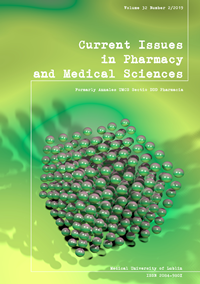In vitro evaluation of anticancer activity of sodium hyaluronate-titanium dioxide bionanocomposite
DOI:
https://doi.org/10.2478/cipms-2019-0019Keywords:
Anticancer, nanocomposite, Taguchi method., TiO2 nanoparticles, sodium hyaluronate, biopolymerAbstract
The purpose of the current research is to optimize the synthesis of sodium hyaluronatetitanium dioxide nanocomposite with the highest anticancer activity. To this end, the Taguchi method was followed to design nine experiments with different ratios of sodium hyaluronate biopolymer, titanium dioxide nanoparticles and stirring times. The results of scanning electron microscopy (SEM) confirmed the synthesis of the nanoparticle and nanocomposite. The comparison of anticancer activity level of synthesized nanocomposites using MTT assay showed that the nanocomposite synthesized in the conditions of experiment 9 (8 mg/ml of titanium dioxide nanoparticles, 2 mg/ml of sodium hyaluronate biopolymer and 60 min stirring time) had the maximum anticancer activity against Michigan Cancer Foundation-7 (MCF-7) cell line. According to the results, the Taguchi method can be employed as an effective and useful strategy to save time and cost in order to determine the optimal conditions for the synthesis of sodium hyaluronate-titanium dioxide nanocomposite with the most favorable anticancer activity.
References
1. Kumar L, Verma S, Prasad DN, Bhardwaj A, Vaidya B, Jain AK. Nanotechnology: a magic bullet for HIV AIDS treatment. Artif Cells Nanomed Biotechnol. 2015;43(2):71-86.
2. Mozaffari HR, Zavattaro E, Abdolahnejad A, Lopez-Jornet P, Omidpanah N, Sharifi R, Sadeghi M, et al. Serum and Salivary IgA, IgG, and IgM Levels in Oral Lichen Planus: A Systematic Review and Meta-Analysis of Case-Control Studies. Medicina. 2018;54:99.
3. Taran M, Etemadi S, Safaei M. Microbial levan biopolymer production and its use for the synthesis of an antibacterial iron (II, III) oxide–levan nanocomposite. J Appl Polym Sci. 2017;134(12): 44613.
4. Sharifi R, Khazaei S, Mozaffari HR, Amiri SM, Iranmanesh P, Mousavi SA. Effect of massage on the success of anesthesia and infiltration injection pain in maxillary central incisors: Double-blind, crossover trial. Dent Hypotheses. 2017;8(3):61-4.
5. Mozaffari HR, Izadi B, Sadeghi M, Rezaei F, Sharifi R, Jalilian F. Prevalence of oral and pharyngeal cancers in Kermanshah province, Iran: A ten-year period. Int J Cancer Res. 2016;12(3-4):169-175.
6. Mozaffari HR, Payandeh M, Ramezani M, Sadeghi M, Mahmoudiahmadabadi M, Sharifi R. Efficacy of palifermin on oral mucositis and acute GVHD after hematopoietic stem cell transplantation (HSCT) in hematology malignancy patients: a meta-analysis of trials. Wspolczesna Onkol. 2017;21(4):299-305.
7. Parsa N. Environmental factors inducing human cancers. Iran J Public Health. 2012;41(11):1-9.
8. Brawley OW. Avoidable cancer deaths globally. CA Cancer J Clin. 2011;61(2):67-8.
9. Gopalan MR, Karunakaran V, Prabhakaran A, Jayakumar KL. Prevalence of psychiatric morbidity among cancer patients–hospital-based, cross-sectional survey. Indian J Psychiatry. 2016;58(3):275-80.
10. Safaei M, Taran M. Optimized synthesis, characterization, and antibacterial activity of an alginate–cupric oxide bionanocomposite. J Appl Polym Sci. 2018;135(2):45682.
11. Shi J, Kantoff PW, Wooster R, Farokhzad OC. Cancer nanomedicine: progress, challenges and opportunities. Nat Rev Cancer. 2017;17(1): 20-37.
12. Weir A, Westerhoff P, Fabricius L, Hristovski K, Von Goetz N. Titanium dioxide nanoparticles in food and personal care products. Environ Sci Technol. 2012;46(4):2242-50.
13. Safaei M, Taran M. Fabrication, characterization, and antifungal activity of sodium hyaluronate-TiO2 bionanocomposite against Aspergillus niger. Mater Lett. 2017;207:113-6.
14. Boeriu CG, Springer J, Kooy FK, Van den Broek LA, Eggink G. Production methods for hyaluronan. Int J Carbohyd Chem. 2013:624967.
15. Safaei M, Taran M. Optimal conditions for producing bactericidal sodium hyaluronate-TiO2 bionanocomposite and its characterization. Int J Biol Macromol. 2017;104:449-56.
16. Arunkumar P, Vedagiri H, Premkumar K. Rapid bioreduction of trivalent aurum using banana stem powder and its cytotoxicity against MCF-7 and HEK-293 cell lines. J Nanopart Res. 2013;15(3): 1481.
17. Rezaei R, Mostafaie A, Gorgin Karaji A, Mansouri K. The effect of standardized extract of Echinacea Purpurea on cytotoxicity and proliferation of rat splenocytes. J Appl Biol Sci. 2015;9(2):19-22.
18. Ren W, Zeng L, Shen Z, Xiang L, Gong A, Zhang J, et al. Enhanced doxorubicin transport to multidrug resistant breast cancer cells via TiO2 nanocarriers. RSC Adv. 2013;3(43):20855-61.
19. Latha TS, Reddy MC, Muthukonda SV, Srikanth VV, Lomada D. In vitro and in vivo evaluation of anti-cancer activity: Shape-dependent properties of TiO2 nanostructures. Mater Sci Eng C. 2017;78:969-77.
20. Tong R, Lin H, Chen Y, An N, Wang G, Pan X, Qu F. Near-infrared mediated chemo/photodynamic synergistic therapy with DOX-UCNPs@ mSiO2/TiO2-TC nanocomposite. Mater Sci Eng C. 2017;78: 998-1005.
21. Yamaguchi S, Kobayashi H, Narita T, Kanehira K, Sonezaki S, Kubota Y, et al. Novel Photodynamic Therapy Using Water‐dispersed TiO2–Polyethylene Glycol Compound: Evaluation of Antitumor Effect on Glioma Cells and Spheroids In vitro. J Photochem Photobiol. 2010;86(4):964-71.
22. Chakra CS, Rajendar V, Rao KV, Kumar M. Enhanced antimicrobial and anticancer properties of ZnO and TiO2 nanocomposites. 3 Biotech. 2017; 7(2):89.
23. Danhier F, Feron O, Preat V. To exploit the tumor microenvironment: passive and active tumor targeting of nanocarriers for anti-cancer drug delivery. J Control Release. 2010;148(2):135-46.
24. Vinardell MP, Mitjans M. Antitumor activities of metal oxide nanoparticles. Nanomaterials. 2015;5(2):1004-21.
25. Gopinath P, Gogoi SK, Sanpui P, Paul A, Chattopadhyay A, Ghosh SS. Signaling gene cascade in silver nanoparticle induced apoptosis. Colloids Surf B Biointerfaces. 2010;77(2):240-5.
Downloads
Published
Issue
Section
License
Copyright (c) 2019 Autors

This work is licensed under a Creative Commons Attribution-NonCommercial-NoDerivatives 3.0 Unported License.


